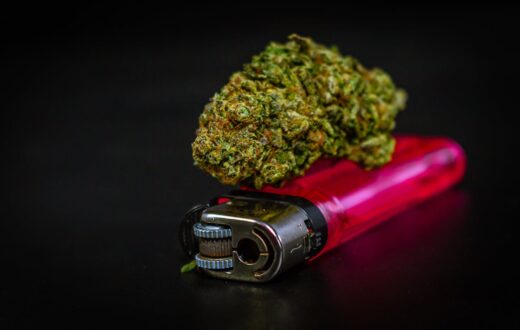Introduction to Amnesia Haze Autoflower
Amnesia Haze Autoflower is a notable strain in the world of cannabis, cherished for its unique characteristics and robust genetics. Originating from a mix of various landrace strains, including the legendary Haze and other hybrid cultivars, this autoflowering variety has captured the attention of growers and enthusiasts alike. Its genetic lineage provides a comprehensive blend of uplifting effects and stress relief, making it a desirable choice for both recreational and medicinal users.
This strain stands out not only for its intoxicating effects but also for its ease of cultivation. Autoflowering cannabis strains like Amnesia Haze Autoflower undergo a rapid growth cycle, transitioning from the vegetative to the flowering stage automatically, governed by the age of the plant rather than the light cycle. This feature appeals particularly to novice growers or those who prefer a low-maintenance approach, making it easier to achieve success without extensive knowledge of lighting conditions.
The unique qualities of Amnesia Haze Autoflower also contribute to its popularity. It boasts high THC levels, often exceeding 20%, delivering a potent euphoric high. This strain typically presents a complex flavor profile, with hints of citrus and earthy undertones that tantalize the palate. Additionally, its resilience to common pests and diseases enables growers to have higher yields, particularly in less-than-ideal conditions. Given its capacity for high yields and appealing effects, many cultivators aim to master the art of growing this particular autoflower. As more enthusiasts discover the advantages of Amnesia Haze Autoflower, its reputation as an exceptional choice in the cannabis community continues to grow.
Understanding Autoflowering Cannabis
Autoflowering cannabis refers to a specific type of cannabis that transitions from the vegetative stage to the flowering stage based on age rather than light cycles. Unlike traditional photoperiod strains, which require a specific light schedule—typically 12 hours of light and 12 hours of darkness—to initiate flowering, autoflowering strains like Amnesia Haze Autoflower shift to flowering automatically after a certain number of weeks. This unique trait makes them particularly appealing for both novice and experienced growers.
One of the primary advantages of growing autoflowering cannabis is the accelerated growth cycle. Autoflowering strains can go from seed to harvest in as little as eight weeks, significantly reducing the overall cultivation time compared to photoperiod strains that may require several months. This swift growth is especially beneficial for growers in regions with shorter growing seasons or for those looking to maximize multiple harvests in a single year.
Another significant benefit is the reduced dependence on light conditions. Autoflowering plants typically thrive in a wide range of light conditions—they can perform well with as little as 18 hours of light per day. This versatility allows growers to introduce them into various environments, including indoor and outdoor setups, without the need to meticulously manage light cycles. Moreover, their smaller size compared to photoperiod strains often means that they require less space and can be cultivated in more confined areas, making them an accessible option for beginners or those with limited growing space.
In summary, understanding autoflowering cannabis is crucial for anyone interested in cultivating strains like Amnesia Haze Autoflower. The characteristics of these plants make them advantageous for a variety of growers, from seasoned experts to those just starting their journey into cannabis cultivation.
Growing Environment: Ideal Conditions for Amnesia Haze
Creating an optimal growing environment is crucial for successfully cultivating Amnesia Haze Autoflower. This strain thrives under specific conditions that can significantly enhance its yield and overall growth quality. To begin with, temperature plays a pivotal role in the development of Amnesia Haze. Ideally, daytime temperatures should range between 70°F to 85°F (20°C to 29°C). Nighttime temperatures can drop slightly, but should not fall below 60°F (15°C) to ensure the plant’s respiration continues effectively.
Humidity levels are another key factor for the growth of Amnesia Haze Autoflower. During the vegetative phase, maintain humidity levels around 40% to 60%. This moisture is essential for proper growth and development. However, as the plants transition into the flowering phase, it is advisable to lower the humidity to approximately 40% to 50%. Keeping humidity in check helps prevent mold and mildew, which can devastate the crop.
Light is vital for the growth of Amnesia Haze. For optimal results, ensure your plants receive at least 18 hours of light a day. In indoor environments, employing high-quality LED or HID lights is recommended. These grow lights should be positioned appropriately to ensure even light distribution across the plants. When growing outdoors, select a location that provides plenty of direct sunlight to foster the best growth conditions.
Soil quality is equally important for supporting the healthy growth of Amnesia Haze Autoflower. Using a well-draining soil mix enriched with organic matter can lead to optimal nutrient uptake. A pH level between 6.0 to 7.0 is preferred, as it supports the overall health and vigor of the plants. Furthermore, integrating organic fertilizers can enhance soil nutrient richness, contributing positively to plant growth and yield.
By carefully managing temperature, humidity, light, and soil conditions, growers can create an ideal environment that encourages robust growth for Amnesia Haze Autoflower, leading to a successful harvest.
Nutrient Requirements and Feeding Schedule
Understanding the nutrient requirements of Amnesia Haze Autoflower is essential for successful cultivation, as these plants have specific needs that evolve throughout their growth stages. During the seedling phase, it is crucial to provide a balanced nutrient mix, although caution is important as seedlings are sensitive to excessive feeding. A starter nutrient solution with lower concentration levels will suffice, typically containing nitrogen (N), phosphorus (P), and potassium (K) in equal ratios. Ideally, seedlings should begin with a nutrient solution diluted to one-quarter strength to avoid nutrient burn.
As the plant transitions into the vegetative stage, its nutrient requirements shift slightly. Increased nitrogen is essential during this period to promote healthy leaf and stem growth. The ideal NPK ratio during this phase should be approximately 3-1-2. Utilizing organic fertilizers can be beneficial, as they often provide a more gradual release of nutrients, which aligns well with the needs of Amnesia Haze Autoflower. It is recommended to feed the plants every two weeks, ensuring that the soil remains moist but not waterlogged to prevent root rot.
In the flowering stage, it becomes imperative to switch the nutrient focus from nitrogen to phosphorus and potassium, helping to enhance blooming and overall yield. A typical NPK ratio during this stage would be 1-3-4. Compost teas or specialized flowering nutrients can be introduced to support the development of dense, resinous buds. Maintaining a regular feeding schedule is crucial; feeding every week or every other week can yield significant benefits, yet it is essential to keep an eye on the plant’s response and adjust accordingly. Continuous monitoring of pH levels and nutrient deficiencies during all stages will ensure that you are effectively nurturing your Amnesia Haze Autoflower, maximizing growth and yield potential.
Watering Techniques for Optimal Growth
When cultivating Amnesia Haze Autoflower, understanding the significance of effective watering techniques is crucial for ensuring optimal growth and development. The frequency of watering plays a pivotal role in maintaining the balance required for healthy plants. Generally, the ideal watering schedule for Amnesia Haze Autoflower involves assessing the moisture level of the soil rather than adhering strictly to a pre-set timetable. A deep watering once the top inch of the soil feels dry encourages robust root development, allowing the plant to access essential nutrients while preventing over-saturation.
Observing the plant for signs of overwatering and underwatering is essential for successful cultivation. Typical indicators of overwatering include drooping leaves, a yellowing appearance, and a musty odor from the soil. If these symptoms are evident, it might be necessary to adjust the watering schedule to avoid root rot, which can severely affect the plant’s growth. Conversely, underwatering may manifest as crispy or wilting leaves, stressing the plant and leading to stunted growth. Thus, monitoring these signs can help maintain the health of your Amnesia Haze Autoflower.
Maintaining balanced soil moisture levels is vital for Amnesia Haze Autoflower’s healthy development. Utilizing techniques such as bottom watering, where the pot is placed in a tray of water, can encourage the roots to absorb moisture gradually without flooding the upper soil layer. Additionally, adding organic matter to the soil can enhance its water retention capacity, providing the plant with consistent moisture without the risk of waterlogging. Overall, mastering these watering techniques will contribute significantly to the flourishing growth of Amnesia Haze Autoflower, leading to a successful harvest.
Managing Pests and Diseases
Successfully cultivating Amnesia Haze Autoflower requires not only an optimal environment and proper nutes but also vigilant management of pests and diseases that can threaten your plants. This strain, while robust, is not impervious to the common challenges faced in indoor and outdoor growing. Key pests that can infest your Amnesia Haze plants include spider mites, aphids, and whiteflies. These pests tend to suck the sap from the leaves, leading to stunted growth and, in severe cases, plant death.
To counteract these infestations, employing Integrated Pest Management (IPM) techniques is crucial. This holistic approach emphasizes preventive measures and combines various strategies to manage pests effectively. Start by regularly inspecting your plants for early signs of infestations, such as discolored or deformed leaves. Maintaining a clean growing environment is essential; remove dead leaves and debris where pests might breed. Using beneficial insects, such as ladybugs or predatory mites, can also aid in controlling pest populations while minimizing the use of harmful chemicals.
Additionally, organic options can be very effective in managing diseases and pests. Neem oil, for example, works as a deterrent for many pests and fungi while also promoting a healthy plant system. Regularly treating your Amnesia Haze Autoflower plants with a diluted solution of neem oil can help maintain their health and vigour. Avoiding overwatering and ensuring adequate air circulation will also lessen the risk of root rot and fungal diseases common in humid environments.
In summary, protecting your Amnesia Haze Autoflower from pests and diseases is key to achieving a bountiful harvest. Implementing an IPM approach and utilizing organic solutions can significantly enhance plant health and resilience, thereby ensuring that your cultivation experience is successful and rewarding.
Harvesting and Curing Amnesia Haze Autoflower
Harvesting Amnesia Haze Autoflower involves a careful evaluation of trichome development to ensure optimal potency and flavor. Knowing when to harvest is crucial, as this significantly influences the final product. The ideal time to harvest is generally indicated by the appearance of the trichomes on the buds. Clear trichomes suggest that the plant is not ready, while cloudy trichomes indicate peak potency. A mix of cloudy and amber trichomes is usually considered the best time to cut the plants, as this balance offers both high THC levels and a smoother smoke. Observing the color and development of trichomes with a jeweler’s loupe or microscope is recommended for accuracy.
Once the plants are harvested, the next step is curing the Amnesia Haze Autoflower to enhance its flavor and potency. Curing involves drying the buds at a gradual pace to preserve their qualities. Start by hanging the harvested branches upside down in a dark, ventilated space with controlled humidity levels. This method allows moisture to exit slowly, preventing mold growth. The drying process typically takes around seven to fourteen days, depending on environmental conditions. Once the buds feel dry to the touch, it’s time to trim them and place them in glass jars for curing.
Curing in jars is a vital step that boosts the overall quality of the buds. Fill the jars about three-quarters full and seal them, ensuring to open them daily for five to ten minutes to release excess moisture and introduce fresh air. This process should continue for at least two to four weeks; longer curing periods can enhance flavor and potency further. The key to successfully growing Amnesia Haze Autoflower lies not just in the cultivation phase but also in following proper harvesting and curing practices.
Common Challenges and Solutions
Growing Amnesia Haze Autoflower can be an enriching experience, but like any other plant, it comes with its set of challenges. Understanding these obstacles and their solutions is crucial for successful cultivation. One significant challenge is space constraints. Autoflowering strains, while generally compact, still require adequate room to grow structurally and to access sufficient light. To address this, choose a growing area that maximizes light exposure and airflow. Consider using pots that allow for healthy root development, which will help your plants thrive even in limited spaces.
Another common issue is the impact of weather conditions on growth. Amnesia Haze Autoflower is sensitive to extreme temperatures and excessive moisture. It is essential to maintain a stable environment, ideally between 68-77°F (20-25°C) for optimal growth. If growing outdoors, select a period with stable weather patterns to avoid the adverse effects of storms or frost. For indoor growers, investing in climate control systems or ventilation can create a stable environment that promotes healthy development.
Nutrient deficiencies also represent a common challenge when cultivating this strain. Amnesia Haze Autoflower typically requires a balanced feeding schedule, as it can be vulnerable to both excess and deficiency of nutrients. Conduct regular soil tests to determine nutrient levels and adjust feeding accordingly. Using a high-quality soil mix enriched with organic amendments can significantly improve nutrient availability. Furthermore, incorporating a light feeding schedule, especially during the flowering phase, can help optimize plant health.
By recognizing these common challenges and implementing practical solutions, growers can enhance their experience with Amnesia Haze Autoflower. Through careful planning and management, successful growth of this remarkable strain can truly be achieved.
Conclusion: Why Amnesia Haze Autoflower is Worth Growing
Amnesia Haze Autoflower stands out as an exceptional choice for both novice and experienced cultivators due to its unique characteristics and remarkable growth attributes. This strain’s robust nature makes it well-suited for various growing conditions, providing a level of flexibility that many growers seek. One of the primary advantages of cultivating Amnesia Haze Autoflower is its incredible ease of growth. Autoflowering cannabis plants require less attention to light cycles compared to photoperiod strains, making it an ideal option for individuals who may have limited time or experience.
Another compelling reason to consider growing Amnesia Haze Autoflower is its impressive yield potential. When properly cultivated, this strain can produce considerable yields, making it a fruitful endeavor for those looking to maximize their harvest. Moreover, the quality of the buds is noteworthy, displaying a striking combination of potency and flavor that cultivators and consumers alike will appreciate. The high THC content, coupled with distinct earthy and citrus notes, ensures that Amnesia Haze Autoflower delivers a remarkable experience, which is often sought after in the cannabis community.
Furthermore, Amnesia Haze Autoflower’s resilience to pests and diseases enhances its attractiveness for growers concerned about potential setbacks. This hardiness contributes to a smoother growing process, allowing cultivators to focus on nurturing the plants rather than battling issues. In conclusion, the ease of cultivation, excellent yield potential, and superior quality of the final product make Amnesia Haze Autoflower a worthy addition to any grower’s repertoire. As such, it is highly recommended for individuals eager to explore and enjoy this distinguished strain in their next cultivation project.














